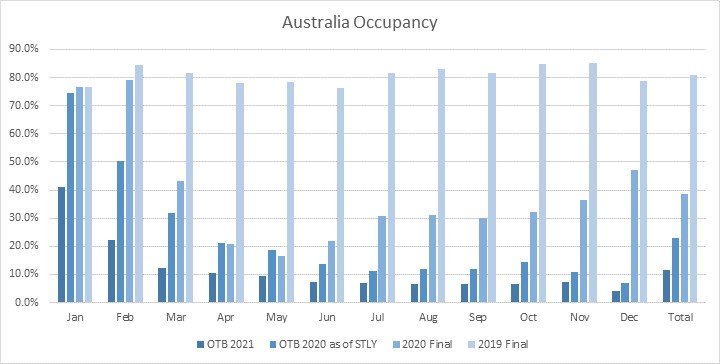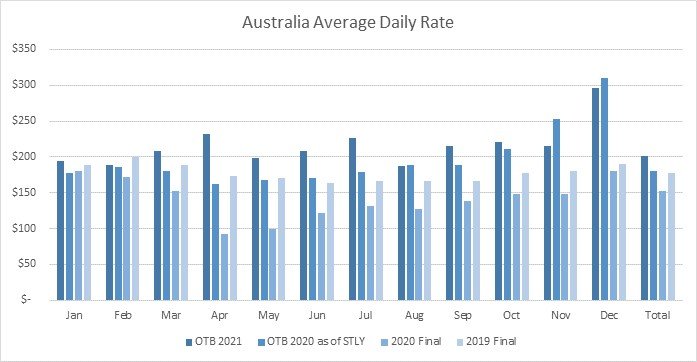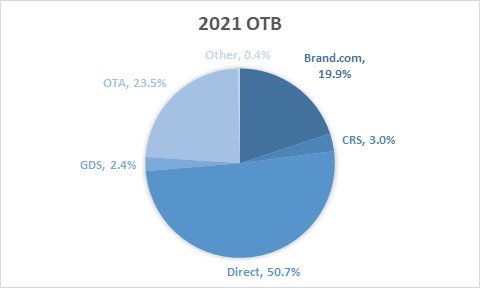
Originally published on Amadeus Insights
By: Maria Taylor, Head of Commercial, Asia Pacific, Hospitality, Amadeus
As Australia lifts its internal border restrictions once more, pent up travel demand is boosting domestic hotel occupancy according to the latest forward-looking data from Amadeus’ Demand360® solution. In the later part of 2020, this same region saw a gradual increase in occupancy with November approaching 40% and December approaching 50%. January has seen a slight reduction with some shifts in travel restrictions, but very short booking lead times offer optimism as the majority of travelers are booking within 0-7 days of travel.

Source: Amadeus’ Demand360® as of January 27, 2021Source: Amadeus’ Demand360® as of January 27, 2021
With the recovery of international travel still an unknown, here are 3 trends that Australian hoteliers should address now to drive more domestic bookings in the year ahead.
1. Demand for safety, cleanliness and flexibility
Safety, cleanliness and booking flexibility have emerged as three of the most important factors for Australians when it comes to making travel decisions. Whilst previously hotels would have competed on price, service and location, reassuring guests of their safety, delivering on cleanliness for the “Generation Clean” traveler and offering flexible cancellation policies are the new battlegrounds to attract customers in 2021.
When it comes to safety, contactless technology will be paramount – from self-serve check-in to robot concierges.
Maintaining flexible cancellation policies and bookings will also be important as recovery continues and will be the new currency for loyalty. AI-powered planning and revenue management tools will be needed to help Australia’s hotels analyze bookings and operate profitably in this new climate. In particular, hotels should embrace the use of live sales data to adjust their demand forecast in real-time based on forward-looking booking data, rather than relying on historic or seasonal data which is becoming irrelevant in these uncertain times. Taking a more real-time approach to demand can enable hotels to respond more intelligently to what their customers need, through tailored merchandising and dynamic pricing.
The good news is that guests who are looking to travel aren’t limited by budget availability as average daily rates (ADR) in the region remain strong. This is good news for hoteliers who are looking to capture available demand.

Source: Amadeus’ Demand360® as of January 27, 2021
2. Rise of direct bookings
The second emerging trend in Australia is that travelers are increasingly booking directly by calling the property or through hotel websites. Data shows that more than 70% of bookings are being made by guests calling the hotel or booking via the hotel website. Whilst OTAs remain important, this trend means that hotels need to invest in optimizing their own websites and marketing strategies too, to increase booking conversion rates.

Source: Amadeus’ Demand360® as of January 27, 2021
More so than ever a hotel’s website will serve as their ‘shop window’, so hotels need to make sure that they are looking their best.
There are 4 ways that hoteliers can consider elevating their digital brand experience and encourage direct bookings.
- The first thing that hotels should do is create a visible FAQ page to address customer concerns and provide regularly updated information. Health and safety are more important than ever, so guests want to know what sanitization policies are in place and that they meet with the latest government advice.
- Having an AI-powered chatbot function available to answer any questions from hotel guests and making contact details of hotel representatives clearly visible, will be something we see more of in the future.
- Strategic media campaigns including pop-ups and banners teamed with the right data and insights are a great way to share promotions, offers and packages for booking inspiration. These can be used to amplify messages on new protocols, safety procedures and initiatives too.
- And last, but certainly not least, hoteliers will also need to ensure a seamless user experience across all devices, from desktop to tablet and mobile. Having a consistent, cross-channel experience encourages customers to book, regardless of the device they are using.
3. Growth of mobile
The third trend Amadeus’ data reveals is a growth in mobile bookings for Australian hotels since the pandemic, possibly because consumers are more comfortable transacting on their mobiles when they book directly with a ‘known’ hotel brand. This means that mobile optimization is also paramount for hotels’ websites, and that mobile needs to be a key part of every hoteliers’ marketing mix too.
The first consideration for a mobile strategy is ensuring a unified research and booking experience across channels, as customers are likely to toggle between different devices.
Hotels can use cookie data to inform their mobile strategy and improve guest experience. Cookies can be used to track which areas of a hotel’s website (on mobile and desktop) are performing well and which aren’t, and these can be redesigned as needed.
Additionally, cookies can also help hotels to identify a customer and know their history and preferences, regardless of what channel they are using. This will help hoteliers offer customized and personalized experience, with no hassle to the guest.
Travelers want the latest information at their fingertips, so using mobile communication to keep them informed will also be key. This communication can vary from notifying them of the latest offers, to sharing the hotel’s updated hygiene and safety protocols, to information about their upcoming bookings.
Uncertainty prevails, but early signs of green shoots are encouraging. These consumer trends may be here to stay, so Australia’s hotels need to rethink their sales and marketing strategies – with a focus on safety, flexibility and mobile-optimization – to be in the best position to capture the upswing when it comes.
For more information and best practices on crisis recovery, visit our library of content.





